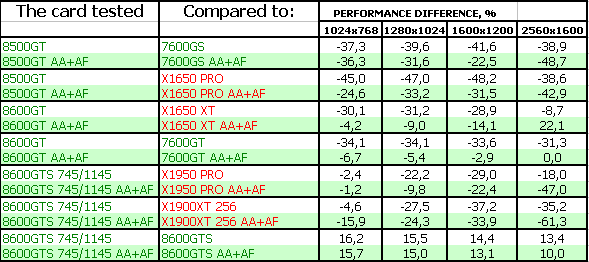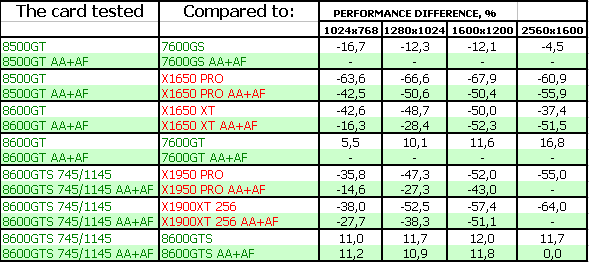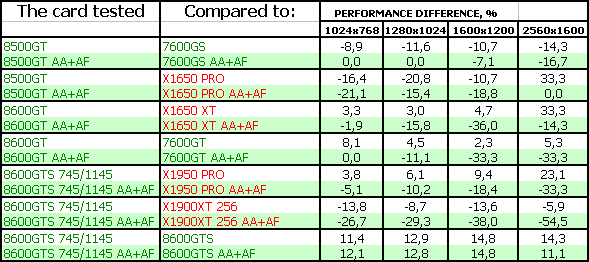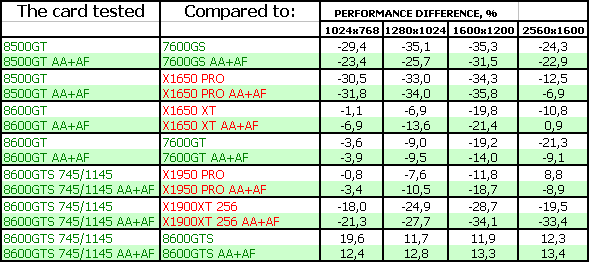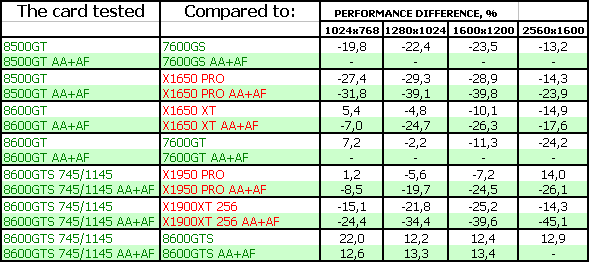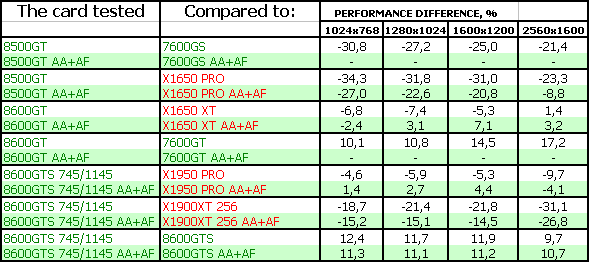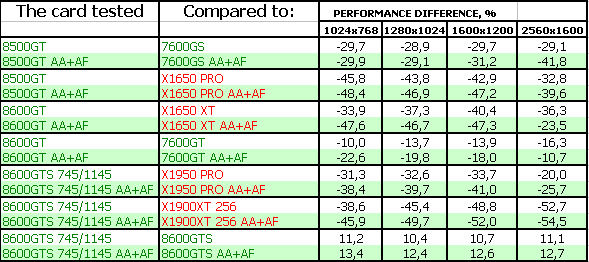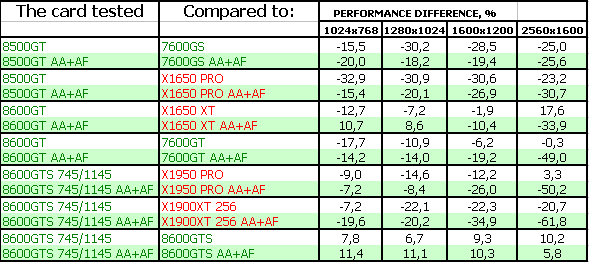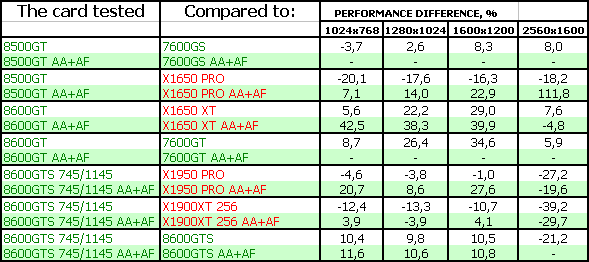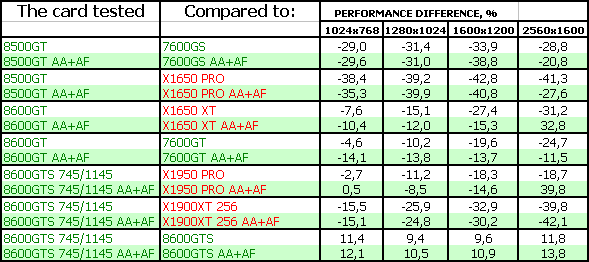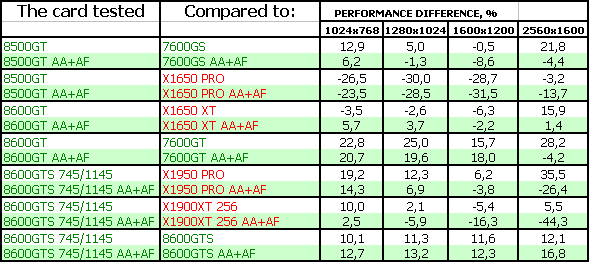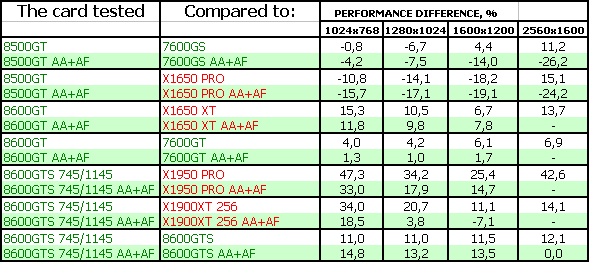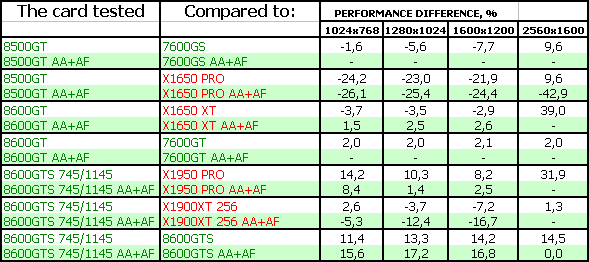ASUS EN8600GTS TOP 256MB PCI-E
Foxconn GeForce 8500 GT 256MB PCI-E
Foxconn GeForce 8600 GT O/C Edition 256MB PCI-E
Foxconn GeForce 8600 GTS 256MB PCI-E
Gigabyte GV-NX86S256H Silent 256MB PCI-E
MSI NX8500GT-TD256E 256MB PCI-E
MSI NX8600GT-TD256E-OC 256MB PCI-E
MSI NX8600GTS-TD256E-OC 256MB PCI-E
Palit GeForce 8500 GT Sonic 256MB PCI-E
Palit GeForce 8600 GT Sonic 256MB PCI-E |
A new series of low- and mid-end graphics cards, based on NVIDIA G84/G86 GPUs, debuted over a month ago.
They share a common distinguishing feature - support for DirectX 10 and unified shaders (that is the GeForce 8800 architecture comes down to cheaper solutions).
As a result, we are offered the following types of graphics cards:
- NVIDIA GeForce 8600 GTS (G84) 256MB GDDR3, 675/1450/2000 MHz, 32 unified processors/16(?) TMUs/8 ROPs
- NVIDIA GeForce 8600 GT (G84) 256MB GDDR3, 540/1180/1600 MHz, 32 unified processors/16(?) TMUs/8 ROPs
- NVIDIA GeForce 8500 GT (G86) 256MB GDDR2, 460/900/800 MHz, 16 unified processors/8 TMUs/8 ROPs
We've already reviewed the top product based on 8600GTS in a large baseline article about the new architecture. Our today's article will describe several cards based on this GPU, but we'll pay most attention to cheaper solutions: 8500GT and 8600GT.
We examined ten graphics cards from various manufacturers, so the article will be long. Unfortunately, none of the 8600GT-based cards operate at stock frequencies (both cards are overclocked). But in our opinion, it won't be a problem to evaluate such products in their price range.
Graphics Cards
| ASUS EN8600GTS TOP 256MB PCI-E |
- GPU: GeForce 8600 GTS (G84)
- Interface: PCI-Express x16
- GPU frequencies (ROPs/Shaders): 745/1620 MHz (nominal - 675/1450 MHz)
- Memory frequencies (physical (effective)): 1145 (2290) MHz (nominal - 1000 (2000) MHz)
- Memory bus width: 128bit
- Vertex processors: -
- Pixel processors: -
- Unified processors: 32
- Texture processors: 16
- ROPs: 8
- Dimensions: 190x100x15 mm (the last figure is the maximum thickness of a graphics card).
- PCB color: green
- RAMDACs/TDMS: integrated into GPU.
- Output connectors: 2xDVI (Dual-Link), TV-Out.
- VIVO: not available
- TV-out: integrated into GPU.
- Multi-GPU operation: SLI (Hardware).
|
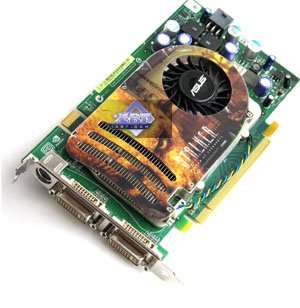
|
| Foxconn GeForce 8500 GT 256MB PCI-E |
- GPU: GeForce 8500 GT (G86)
- Interface: PCI-Express x16
- GPU frequencies (ROPs/Shaders): 460/918 MHz (nominal - 460/918 MHz)
- Memory frequencies (physical (effective)): 400 (800) MHz (nominal - 400 (800) MHz)
- Memory bus width: 128bit
- Vertex processors: -
- Pixel processors: -
- Unified processors: 16
- Texture processors: 8
- ROPs: 8
- Dimensions: 190x100x15 mm (the last figure is the maximum thickness of a graphics card).
- PCB color: green
- RAMDACs/TDMS: integrated into GPU.
- Output connectors: DVI (Dual-Link), VGA, TV-Out.
- VIVO: not available
- TV-out: integrated into GPU.
- Multi-GPU operation: not available.
|
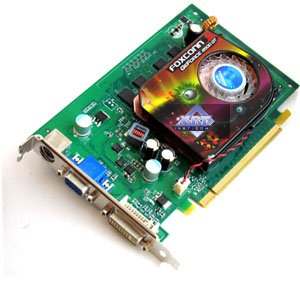
|
| Foxconn GeForce 8600 GT Overclocked Edition 256MB PCI-E |
- GPU: GeForce 8600 GT (G84)
- Interface: PCI-Express x16
- GPU frequencies (ROPs/Shaders): 560/1112 MHz (nominal - 540/1180 MHz)
- Memory frequencies (physical (effective)): 780 (1560) MHz (nominal - 700 (1400) MHz)
- Memory bus width: 128bit
- Vertex processors: -
- Pixel processors: -
- Unified processors: 32
- Texture processors: 16
- ROPs: 8
- Dimensions: 190x100x32 mm (the last figure is the maximum thickness of a graphics card).
- PCB color: green
- RAMDACs/TDMS: integrated into GPU.
- Output connectors: 2xDVI (Dual-Link), TV-Out.
- VIVO: not available
- TV-out: integrated into GPU.
- Multi-GPU operation: SLI (Hardware).
|
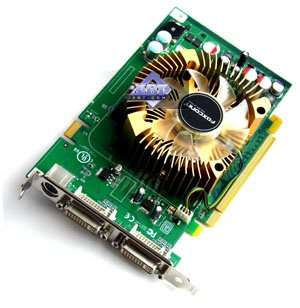
|
| Foxconn GeForce 8600 GTS 256MB PCI-E |
- GPU: GeForce 8600 GTS (G84)
- Interface: PCI-Express x16
- GPU frequencies (ROPs/Shaders): 675/1450 MHz (nominal - 675/1450 MHz)
- Memory frequencies (physical (effective)): 1000 (2000) MHz (nominal - 1000 (2000) MHz)
- Memory bus width: 128bit
- Vertex processors: -
- Pixel processors: -
- Unified processors: 32
- Texture processors: 16
- ROPs: 8
- Dimensions: 190x100x15 mm (the last figure is the maximum thickness of a graphics card).
- PCB color: green
- RAMDACs/TDMS: integrated into GPU.
- Output connectors: 2xDVI (Dual-Link), TV-Out.
- VIVO: not available
- TV-out: integrated into GPU.
- Multi-GPU operation: SLI (Hardware).
|
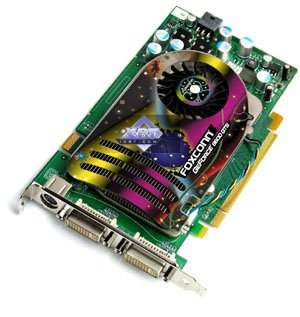
|
| Gigabyte GV-NX86S256H Silent 256MB PCI-E |
- GPU: GeForce 8600 GTS (G84)
- Interface: PCI-Express x16
- GPU frequencies (ROPs/Shaders): 675/1450 MHz (nominal - 675/1450 MHz)
- Memory frequencies (physical (effective)): 1000 (2000) MHz (nominal - 1000 (2000) MHz)
- Memory bus width: 128bit
- Vertex processors: -
- Pixel processors: -
- Unified processors: 32
- Texture processors: 16
- ROPs: 8
- Dimensions: 190x100x33 mm (the last figure is the maximum thickness of a graphics card).
- PCB color: blue
- RAMDACs/TDMS: integrated into GPU.
- Output connectors: 2xDVI (Dual-Link), TV-Out.
- VIVO: not available
- TV-out: integrated into GPU.
- Multi-GPU operation: SLI (Hardware).
|
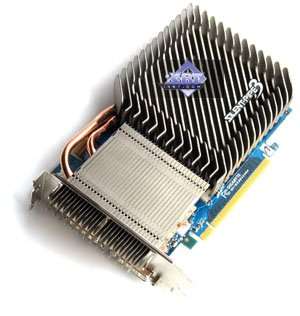
|
| MSI NX8500GT-TD256E 256MB PCI-E |
- GPU: GeForce 8500 GT (G86)
- Interface: PCI-Express x16
- GPU frequencies (ROPs/Shaders): 460/918 MHz (nominal - 460/918 MHz)
- Memory frequencies (physical (effective)): 400 (800) MHz (nominal - 400 (800) MHz)
- Memory bus width: 128bit
- Vertex processors: -
- Pixel processors: -
- Unified processors: 16
- Texture processors: 8
- ROPs: 8
- Dimensions: 190x100x15 mm (the last figure is the maximum thickness of a graphics card).
- PCB color: red
- RAMDACs/TDMS: integrated into GPU.
- Output connectors: DVI (Dual-Link), VGA, TV-Out.
- VIVO: not available
- TV-out: integrated into GPU.
- Multi-GPU operation: not available.
|
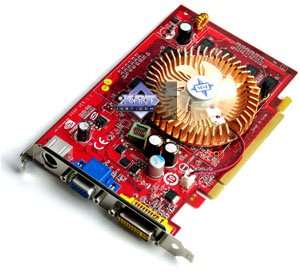
|
| MSI NX8600GT-TD256E-OC 256MB PCI-E |
- GPU: GeForce 8600 GT (G84)
- Interface: PCI-Express x16
- GPU frequencies (ROPs/Shaders): 580/1180 MHz (nominal - 540/1180 MHz)
- Memory frequencies (physical (effective)): 800 (1600) MHz (nominal - 700 (1400) MHz)
- Memory bus width: 128bit
- Vertex processors: -
- Pixel processors: -
- Unified processors: 32
- Texture processors: 16
- ROPs: 8
- Dimensions: 190x100x15 mm (the last figure is the maximum thickness of a graphics card).
- PCB color: red
- RAMDACs/TDMS: integrated into GPU.
- Output connectors: 2xDVI (Dual-Link), TV-Out.
- VIVO: not available
- TV-out: integrated into GPU.
- Multi-GPU operation: SLI (Hardware).
|
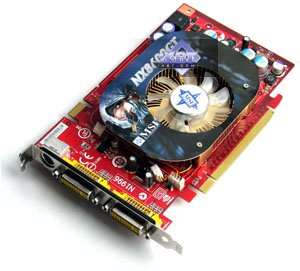
|
| MSI NX8600GTS-TD256E-OC 256MB PCI-E |
- GPU: GeForce 8600 GTS (G84)
- Interface: PCI-Express x16
- GPU frequencies (ROPs/Shaders): 700/1450 MHz (nominal - 675/1450 MHz)
- Memory frequencies (physical (effective)): 1050 (2100) MHz (nominal - 1000 (2000) MHz)
- Memory bus width: 128bit
- Vertex processors: -
- Pixel processors: -
- Unified processors: 32
- Texture processors: 16
- ROPs: 8
- Dimensions: 190x100x15 mm (the last figure is the maximum thickness of a graphics card).
- PCB color: red
- RAMDACs/TDMS: integrated into GPU.
- Output connectors: 2xDVI (Dual-Link), TV-Out.
- VIVO: not available
- TV-out: integrated into GPU.
- Multi-GPU operation: SLI (Hardware).
|
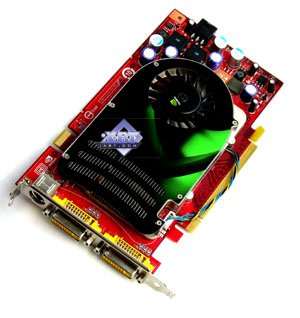
|
| Palit GeForce 8500 GT Sonic 256MB PCI-E |
- GPU: GeForce 8500 GT (G86)
- Interface: PCI-Express x16
- GPU frequencies (ROPs/Shaders): 600/1180 MHz (nominal - 460/918 MHz)
- Memory frequencies (physical (effective)): 600 (1200) MHz (nominal - 400 (800) MHz)
- Memory bus width: 128bit
- Vertex processors: -
- Pixel processors: -
- Unified processors: 16
- Texture processors: 8
- ROPs: 8
- Dimensions: 190x100x15 mm (the last figure is the maximum thickness of a graphics card).
- PCB color: green
- RAMDACs/TDMS: integrated into GPU.
- Output connectors: DVI (Dual-Link), VGA, TV-Out.
- VIVO: not available
- TV-out: integrated into GPU.
- Multi-GPU operation: not available.
|
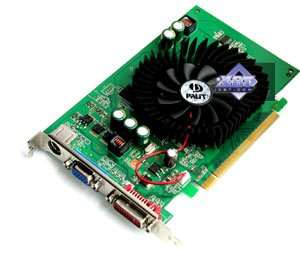
|
| Palit GeForce 8600 GT Sonic 256MB PCI-E |
- GPU: GeForce 8600 GT (G84)
- Interface: PCI-Express x16
- GPU frequencies (ROPs/Shaders): 600/1180 MHz (nominal - 600/1180 MHz)
- Memory frequencies (physical (effective)): 800 (1600) MHz (nominal - 700 (1400) MHz)
- Memory bus width: 128bit
- Vertex processors: -
- Pixel processors: -
- Unified processors: 32
- Texture processors: 16
- ROPs: 8
- Dimensions: 190x100x33 mm (the last figure is the maximum thickness of a graphics card).
- PCB color: green
- RAMDACs/TDMS: integrated into GPU.
- Output connectors: 2xDVI (Dual-Link), TV-Out.
- VIVO: not available
- TV-out: integrated into GPU.
- Multi-GPU operation: SLI (Hardware).
|
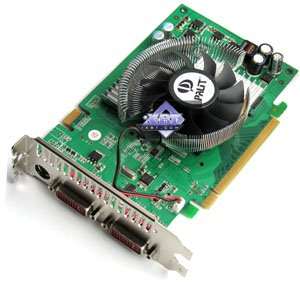
|
ASUS EN8600GTS TOP 256MB PCI-E
Foxconn GeForce 8600 GTS 256MB PCI-E
Gigabyte GV-NX86S256H Silent 256MB PCI-E
MSI NX8600GTS-TD256E-OC 256MB PCI-E |
| Each graphics card has 256 MB of GDDR3 SDRAM allocated in four chips on the front side of the PCB.
Samsung memory chips (GDDR3). 1.0 ns memory access time, which corresponds to 1000 (2000) MHz. |

|
Foxconn GeForce 8600 GT Overclocked Edition 256MB PCI-E
MSI NX8600GT-TD256E-OC 256MB PCI-E |
| Each graphics card has 256 MB of GDDR3 SDRAM allocated in four chips on the front side of the PCB.
Samsung memory chips (GDDR3). 1.4 ns memory access time, which corresponds to 700 (1400) MHz. |

|
Foxconn GeForce 8500 GT 256MB PCI-E
MSI NX8500GT-TD256E 256MB PCI-E |
| Each graphics card has 256 MB of GDDR2 SDRAM allocated in eight chips on the front side of the PCB.
Hynix memory chips (GDDR2). 2.5 ns memory access time, which corresponds to 400 (800) MHz. |
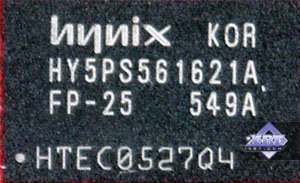
|
| Palit GeForce 8500 GT Sonic 256MB PCI-E |
| The graphics card has 256 MB of GDDR3 SDRAM allocated in four chips on the front side of the PCB.
Infineon memory chips (GDDR3). 1.2ns memory access time, which corresponds to 800 (1600) MHz. |
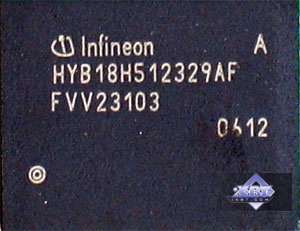
|
| Palit GeForce 8600 GT Sonic 256MB PCI-E |
| The graphics card has 256 MB of GDDR3 SDRAM allocated in four chips on the front side of the PCB.
Infineon memory chips (GDDR3). 1.3 ns memory access time, which corresponds to 750 (1500) MHz. |
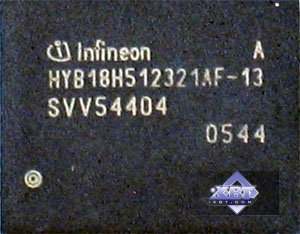
|
| Comparison with the reference design, front view |
| Foxconn GeForce 8500 GT 256MB PCI-E |
Reference card NVIDIA GeForce 7600 GS |
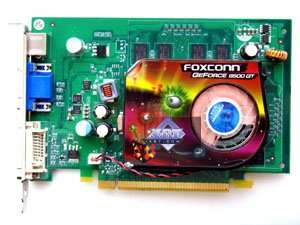
|
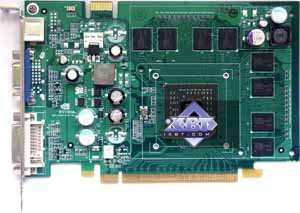
|
| MSI NX8500GT-TD256E 256MB PCI-E |
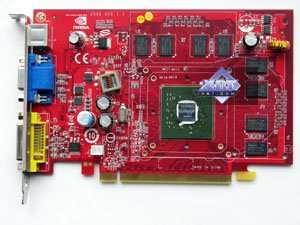
|
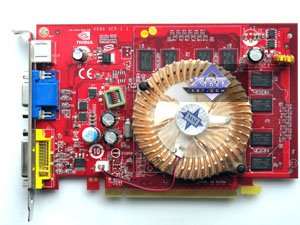
|
| Palit GeForce 8500 GT Sonic 256MB PCI-E |
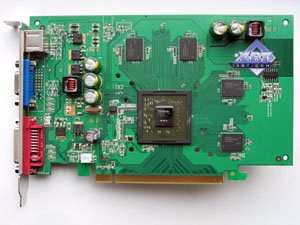
|
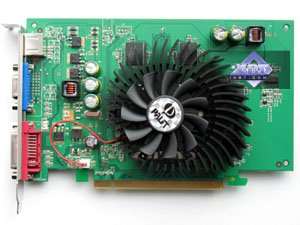
|
| Foxconn GeForce 8600 GT Overclocked Edition 256MB PCI-E |
Reference card NVIDIA GeForce 7600 GT |
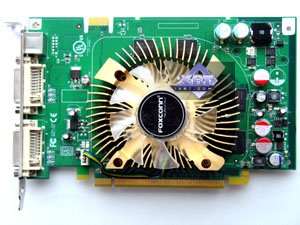
|

|
| MSI NX8600GT-TD256E-OC 256MB PCI-E |
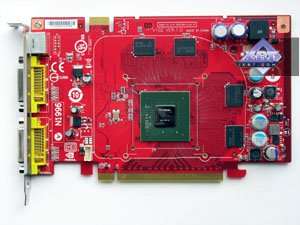
|
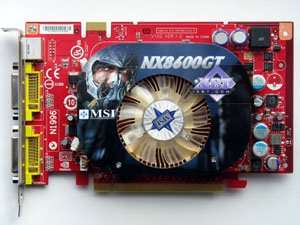
|
| Palit GeForce 8600 GT Sonic 256MB PCI-E |
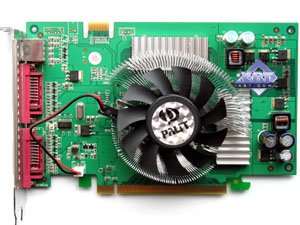
|
| ASUS EN8600GTS TOP 256MB PCI-E |
Reference card NVIDIA GeForce 8600 GTS |
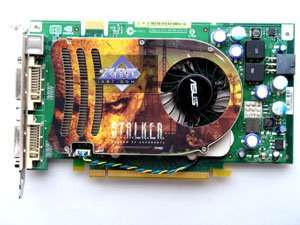
|

|
| Gigabyte GV-NX86S256H Silent 256MB PCI-E |
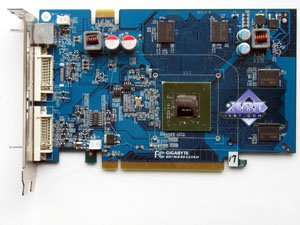
|
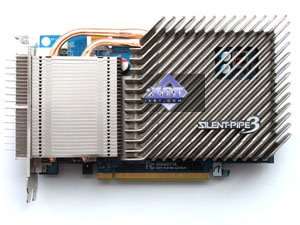
|
| Foxconn GeForce 8600 GTS 256MB PCI-E |
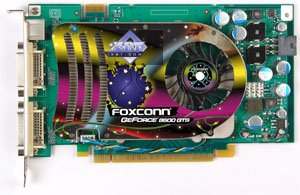
|
| MSI NX8600GTS-TD256E-OC 256MB PCI-E |
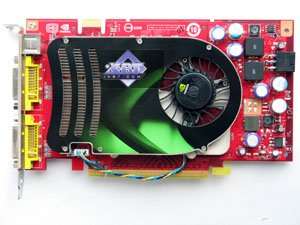
|
| Comparison with the reference design, back view |
| Foxconn GeForce 8500 GT 256MB PCI-E |
Reference card NVIDIA GeForce 7600 GS |
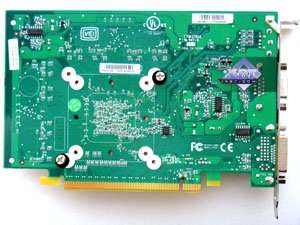
|
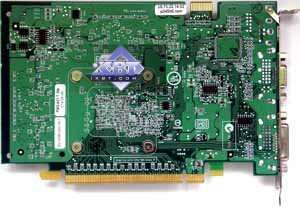
|
| MSI NX8500GT-TD256E 256MB PCI-E |
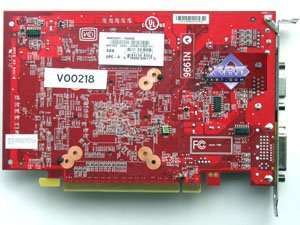
|
| Palit GeForce 8500 GT Sonic 256MB PCI-E |
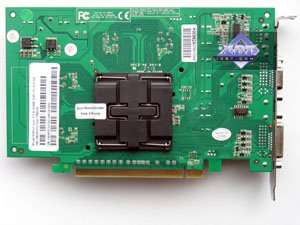
|
| Foxconn GeForce 8600 GT Overclocked Edition 256MB PCI-E |
Reference card NVIDIA GeForce 7600 GT |
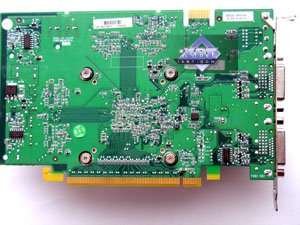
|
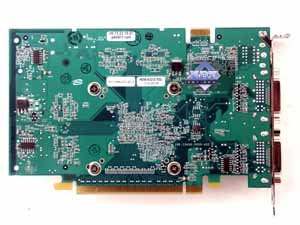
|
| MSI NX8600GT-TD256E-OC 256MB PCI-E |
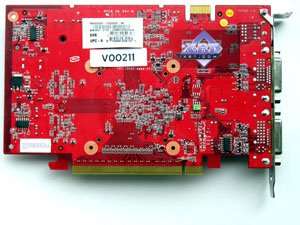
|
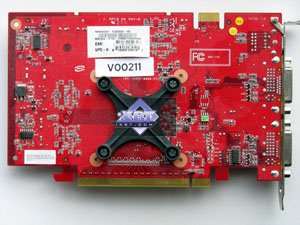
|
| Palit GeForce 8600 GT Sonic 256MB PCI-E |

|
| ASUS EN8600GTS TOP 256MB PCI-E |
Reference card NVIDIA GeForce 8600 GTS |
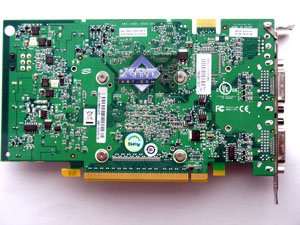
|

|
| Gigabyte GV-NX86S256H Silent 256MB PCI-E |
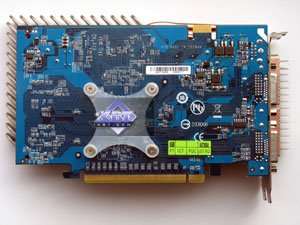
|
| Foxconn GeForce 8600 GTS 256MB PCI-E |
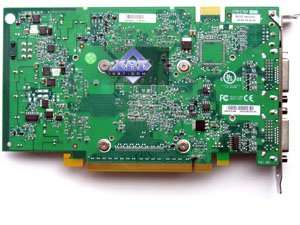
|
| MSI NX8600GTS-TD256E-OC 256MB PCI-E |
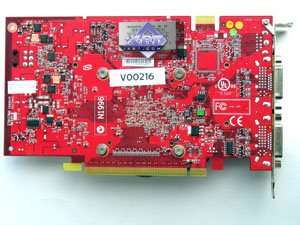
|
Photos of the cards show that all 8600GTS models are copies of the reference design. ASUS and Foxconn present reference cards, manufactured at Flextronics or other plants by NVIDIA's orders. Partners of the Californian company have nothing to do with manufacturing these cards. Except for the graphics card from Gigabyte, which has its own design. The card does not have an external power connector. That is the card is designed to be powered from the PCI-E slot only (it provides up to 75 W). I don't understand why the reference design provides for external power supply. Engineers just wanted to be on the safe side and help overclockers :). The card manufactured by MSI also copies the reference design.
As we can see, the 8500GT reference design is similar to the 7600GS, which also uses DDR2 memory. Except for Palit cards. This manufacturer has been practicing this design for almost Middle- and Low-End solutions. In this case we can see a 8500GT card from Palit with DDR3 memory instead of DDR2. That's why there are only four memory chips instead of eight.
8600GT-based graphics cards are similar to 7600GT in the layout of memory chips. But on the whole, their design is unique.
The cards have TV-Out with a unique jack. You will need a special bundled adapter to output video to a TV-set via S-Video or RCA. You can read about the TV-Out in more detail here.
Analog monitors with d-Sub (VGA) interface are connected with special DVI-to-d-Sub adapters. Maximum resolutions and frequencies:
- 240 Hz Max Refresh Rate
- 2048 x 1536 x 32bit x85Hz Max - analog interface
- 2560 x 1600 @ 60Hz Max - digital interface (all DVI jacks with Dual-Link)
Speaking of MPEG2 playback features (DVD-Video), we analyzed this issue in 2002. Little has changed since that time. CPU load during video playback on modern graphics cards does not exceed 25%. What concerns HDTV and other trendy video features, we are going to sort them out as soon as possible.
Graphics cards based on 8600GTS from ASUS and Foxconn require additional power supply. So each card has a black 6-pin connector. The cards are bundled with a splitter to connect to any power cable with a Molex in case your PSU does not have this cable.
Now about the cooling systems. We shall not describe coolers on the 8600GTS reference cards, because we have already examined them. Foxconn GeForce 8500 GT 256MB PCI-E also comes with the standard cooling device - a closed rectangular heatsink with an off-center fan (similar to coolers used in GeForce4 Ti, we've described them many times). Foxconn GeForce 8600 GT Overclocked Edition 256MB PCI-E uses a usual cooler with a round heatsink (decorated with multiple fins) and a fan in the middle. But the heatsink is very thick, so the graphics card actually takes up two slots.
We monitored temperatures using RivaTuner (written by A.Nikolaychuk AKA Unwinder) and obtained the following results:
Foxconn GeForce 8500 GT 256MB PCI-E, MSI NX8500GT-TD256E 256MB PCI-E
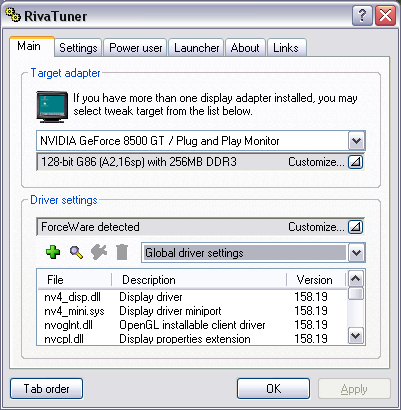
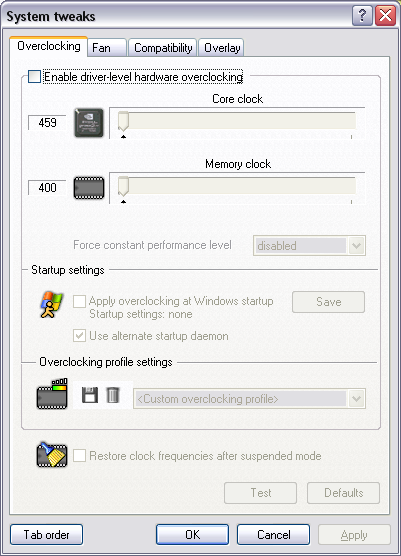
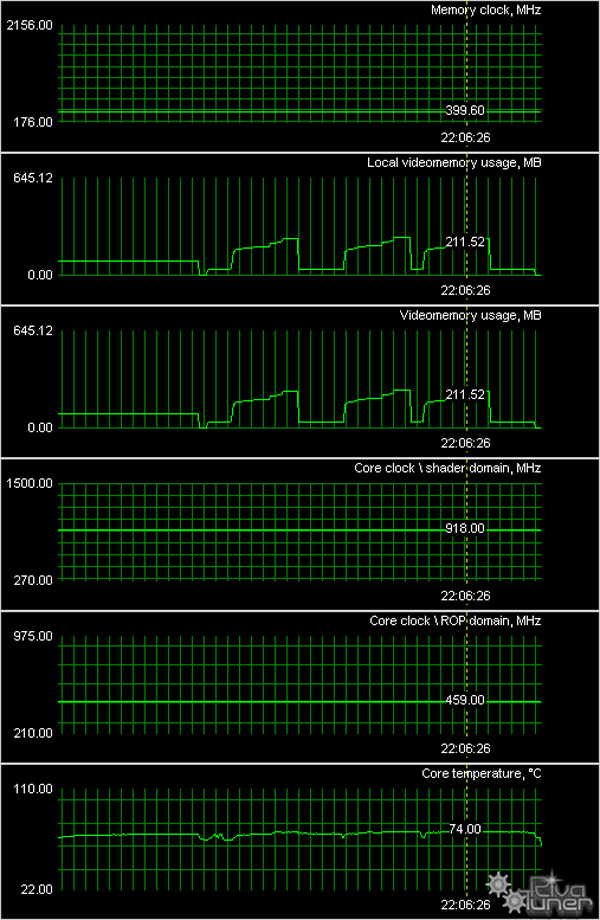
Palit GeForce 8500 GT Sonic 256MB PCI-E
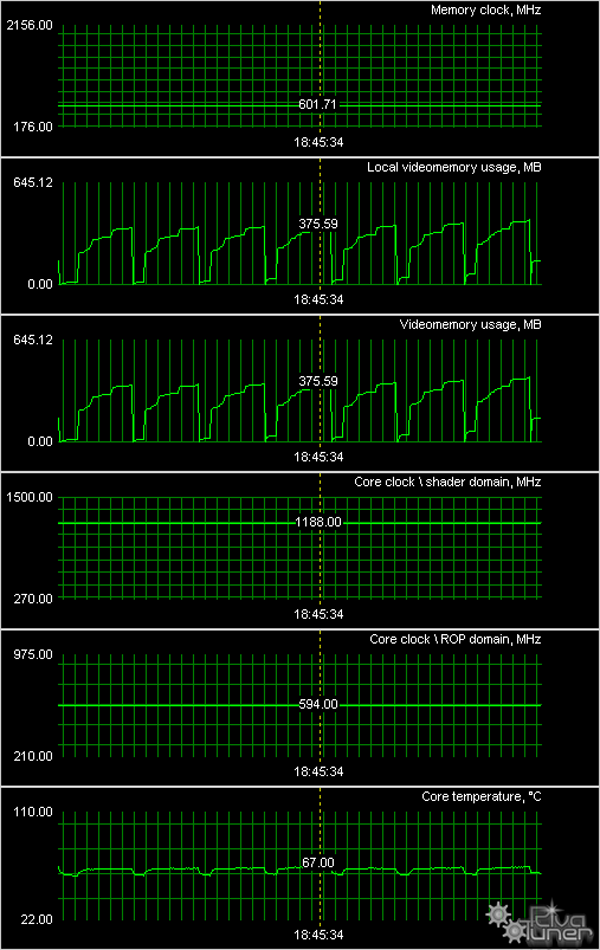
Foxconn GeForce 8600 GT Overclocked Edition 256MB PCI-E

MSI NX8600GT-TD256E-OC 256MB PCI-E
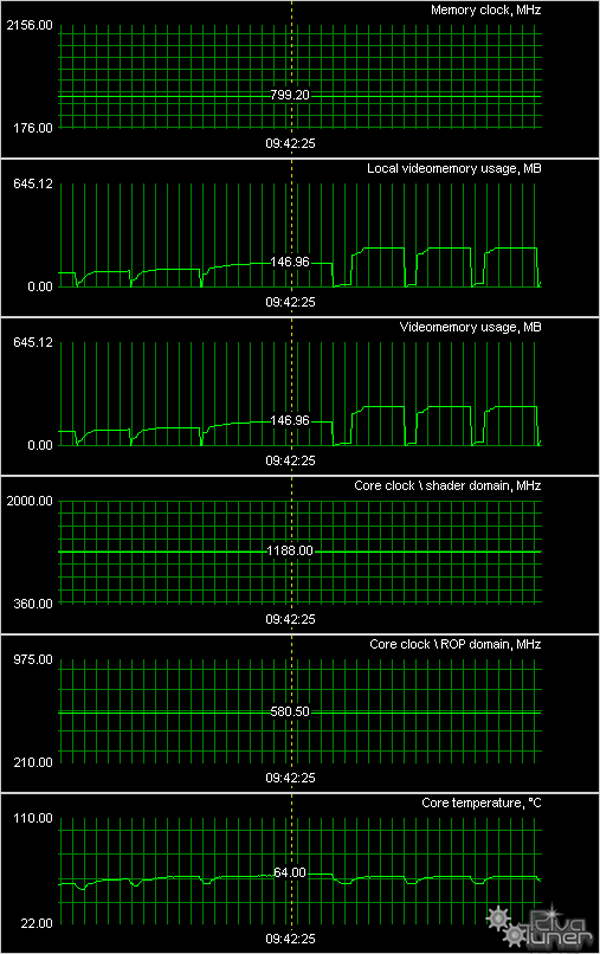
ASUS EN8600GTS TOP 256MB PCI-E

Gigabyte GV-NX86S256H Silent 256MB PCI-E
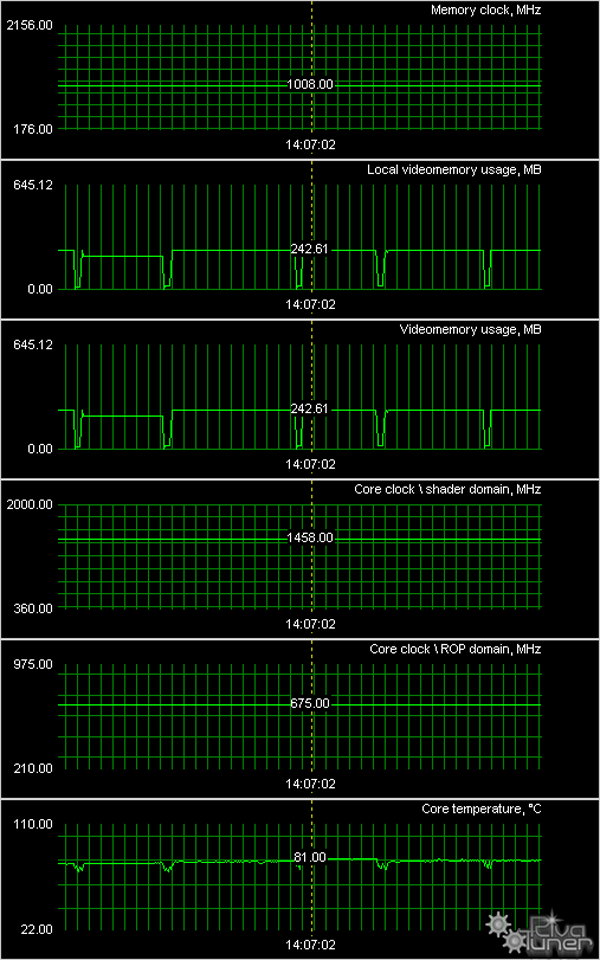
MSI NX8600GTS-TD256E-OC 256MB PCI-E
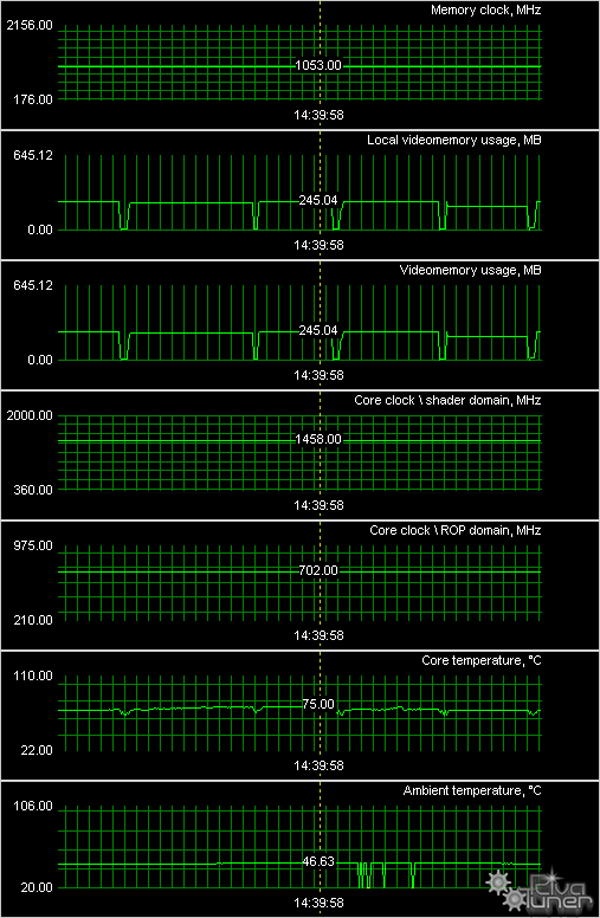
What can we say here? About the Gigabyte card. The core temperature does not reach the dangerous mark (88°C-95°C), even though the fanless cooling system is noiseless. That's good, but we shouldn't forget that the heat is dissipated by a heatsink, which gets very hot and raises the temperature inside a system unit.
Secondly, the other 8600GTS-based cards showed average operating temperatures, there were no overheating emergencies. But you shouldn't forget that the reference cooler in these cards is very noisy.
The other graphics cards did not suffer from overheating either, even though their cooling systems were not noisy.
Bundles
| ASUS EN8600GTS TOP 256MB PCI-E |
| User's Manual, CD with drivers and utilities, a DVI-to-VGA adapter, a component output adapter, an external power adapter. Bonus - a leather album for compact discs. |
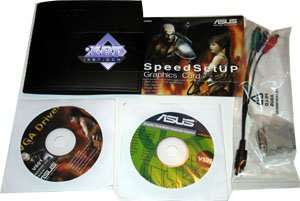
|
Foxconn GeForce 8500 GT 256MB PCI-E
Foxconn GeForce 8600 GT Overclocked Edition 256MB PCI-E
Foxconn GeForce 8600 GTS 256MB PCI-E |
| User's Manual, CD with drivers and utilities, a disc with software (Restore IT v7.0, Virtual DriveProv 10.0) as a bonus, two DVI-to-VGA adapters and a component-output adapter. The 8600GTS also comes with an external power adapter. |

|
| Gigabyte GV-NX86S256H Silent 256MB PCI-E |
| User's Manual, CD with drivers and utilities, Supreme Commander (game), two DVI-to-VGA adapters and a component-output adapter. |
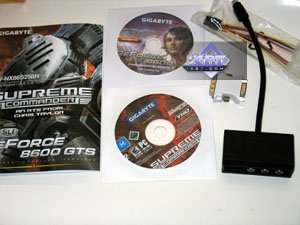
|
MSI NX8500GT-TD256E 256MB PCI-E
MSI NX8600GT-TD256E-OC 256MB PCI-E
MSI NX8600GTS-TD256E-OC 256MB PCI-E |
| User's Manual, CD with drivers and utilities, two DVI-to-VGA adapters, component output adapter, TV extension cords. The 8600GTS also comes with an external power adapter. |
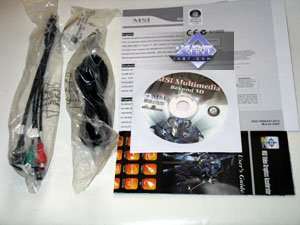
|
Palit GeForce 8500 GT Sonic 256MB PCI-E
Palit GeForce 8600 GT Sonic 256MB PCI-E |
| User's Manual, CD with drivers and utilities, SpellForce2, DVI-to-VGA and component-output adapters. |
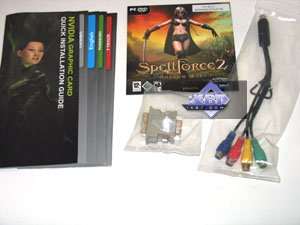
|
Boxes
| ASUS EN8600GTS TOP 256MB PCI-E |
|
A small box made of thick cardboard with an absolutely new design. Light-green palette and a charming Chinese woman in one of historic roles from Asia. It's a nice design (unlike monsters, dark fellows, and Martians we have grown sick and tired of).
Bundled components are arranged into paper sections, the card will not dangle inside. |
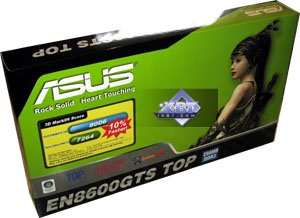
|
Foxconn GeForce 8500 GT 256MB PCI-E
Foxconn GeForce 8600 GT Overclocked Edition 256MB PCI-E
Foxconn GeForce 8600 GTS 256MB PCI-E |
|
Boxes for these cards are almost identical, they differ only in size and labels. They are all made of thick cardboard. The card inside is packed into two envelopes and then put into a special compartment, so damages in transit are out of the question.
|

|
| Gigabyte GV-NX86S256H Silent 256MB PCI-E |
|
The box has a traditional vertical design, brown palette, large labels. The package consists of a glossy jacket with a white cardboard box inside. The card is secured in a foamed polyurethane compartment.
|
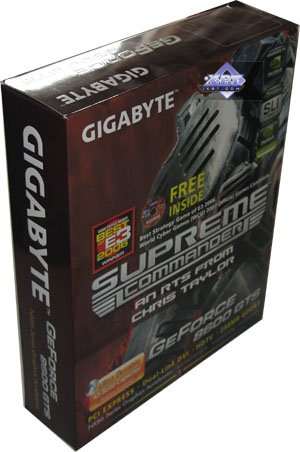
|
| MSI NX8500GT-TD256E 256MB PCI-E |
|
It's a small box made of thick cardboard. All bundled components are arranged into cardboard sections, so the card may dangle inside.
|
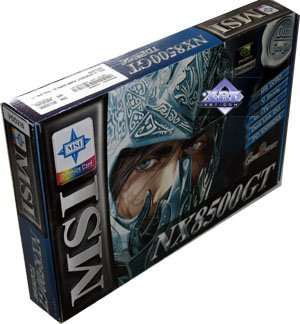
|
MSI NX8600GT-TD256E-OC 256MB PCI-E
MSI NX8600GTS-TD256E-OC 256MB PCI-E |
|
A traditional box (bag). Everything is arranged into segments, the card is thoroughly packed into foamed polyurethane.
|
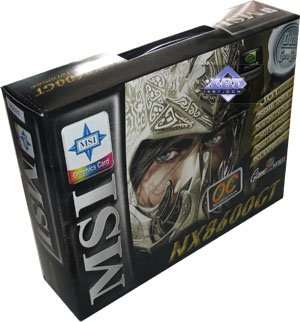
|
Palit GeForce 8500 GT Sonic 256MB PCI-E
Palit GeForce 8600 GT Sonic 256MB PCI-E |
|
A bright glossy box made of thick cardboard with a laser pattern. The box (to be more exact, its lid) has an interesting shape. Bundled components are arranged into cardboard sections inside. But these compartments are tough, so dangling is almost out of the question.
|
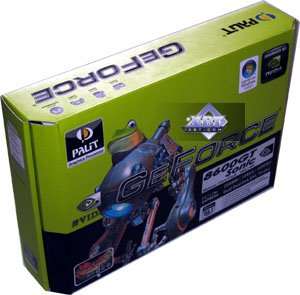
|
Installation and Drivers
Testbed configuration:
- Intel Core2 Duo (775 Socket) based computer
- CPU: Intel Core2 Duo Extreme X6800 (2930 MHz) (L2=4096K)
- Motherboard: EVGA nForce 680i SLI on NVIDIA nForce 680i
- RAM: 2 GB DDR2 SDRAM Corsair 1142MHz (CAS (tCL)=5; RAS to CAS delay (tRCD)=5; Row Precharge (tRP)=5; tRAS=15)
- HDD: WD Caviar SE WD1600JD 160GB SATA
- PSU: Tagan 1100-U95 (1100W).
- Operating system: Windows XP SP2 DirectX 9.0c
- Monitor: Dell 3007WFP (30").
- Drivers: ATI CATALYST 7.4; NVIDIA Drivers 158.18.
VSync is disabled.
Test results: performance comparison
We used the following test applications:
- Splinter Cell Chaos Theory v.1.04 (Ubisoft) - DirectX 9.0, shaders 3.0 (with/without HDR), maximum settings.
- Call Of Juarez (Techland/Ubisoft) - DirectX 9.0, shaders 3.0 (HDR), demo (demo Tests were run with maximum quality. The batch file is included.
- FarCry 1.4 (beta) (Crytek/UbiSoft), DirectX 9.0, shaders 2.0b/3.0 (with/without HDR), 3 demos from the Research level (-DEVMODE startup option), Very High test settings. We used HDRRendering=1 for HDR tests.
- PREY 1.01 (3D Realms Entertainment / Human Head Studios / 2K Games) - OpenGL, shaders 2.x, demo003 (40MB!). Tests were run with maximum quality. The batch file is included.
- 3DMark05 1.20 (FutureMark) - DirectX 9.0, multitexturing, trilinear filtering.
- Serious Sam II 1.068 (Croteam/2K Games) - DirectX 9.0, shaders 3.0 (with/without HDR), batch file to start the test. It's the standard demo0002 that comes with the game. Tests settings - maximum. We express our thanks to our reader, Vozniuk Valery AKA Px, for his batch file to run this game.
- F.E.A.R. v.1.08 (Multiplayer) (Monolith/Sierra) - DirectX 9.0, shaders 2.0, maximum test settings, Soft shadows disabled.
- Company Of Heroes (Relic Entertainment/THQ) - DirectX 9.0, shaders 2.0, startup batch file. When you start the game, you should go to options, choose the graphics section, and press the test button. Tests were run with maximum quality.
- 3DMark06 1.02 (FutureMark) - DirectX 9.0c, multitexturing, trilinear test settings.
Graphics cards' performance
Those of you who are into 3D graphics will understand the charts themselves. And newbies and those who have just begun choosing graphics cards can read our comments.
First of all, you should browse our brief references dedicated to modern graphics card series and underlying GPUs. Note clock rates, shader support, and pipeline architecture.
ATI RADEON X1300-1600-1800-1900 Reference
NVIDIA GeForce 7300-7600-7800-7900 Reference
Secondly, you can browse our 3D graphics section for the basics of 3D and some new product references. There are only two companies that release graphics processing units: ATI (recently merged with AMD and obtained its name) and NVIDIA. Therefore all information is generally separated in two respective parts. You can also read our montly 3Digests, which sums up all graphics card performance charts.
Thirdly, have a look at the test results. We'll not analyze each test, because it makes more sense to draw a bottom line in the end of the article.
FarCry, Research (No HDR)
Test results: FarCry Research (No HDR)
FarCry, Research (HDR)
Test results: FarCry Research (HDR)
F.E.A.R.
Test results: F.E.A.R.
Splinter Cell Chaos Theory (No HDR)
Test results: SCCT (No HDR)
Splinter Cell Chaos Theory (HDR)
Test results: SCCT (HDR)
Call Of Juarez
Test results: СoJ
Company Of Heroes
Test results: CoH
Serious Sam II (No HDR)
Test results: SS2 (No HDR)
Serious Sam II (HDR)
Test results: SS2 (HDR)
Prey
Test results: Prey
3DMark05: MARKS
Test results: 3DMark05 MARKS
3DMark06: SHADER 2.0 MARKS
Test results: 3DMark06 SM2.0 MARKS
3DMark06: SHADER 3.0 MARKS
Test results: 3DMark06 SM3.0 MARKS
Conclusions
So, what can we say about the GeForce 8500 GT? - It's a very weak card, if it's not overclocked. Too many features have been cut down. It cannot compete with similar cards from AMD, even though they don't support DX10. Does this card really need to support this feature? Will DX10 games run fast enough on this card? - It's a rhetorical question. They certainly will, if you disable maximum quality. It cuts both ways: if manufacturers don't launch Low-End cards supporting the new functions, game publishers will not use them (new functions) in their games, motivating the decision by the lack of proper hardware on the market. On the other hand, everybody understands that such a card as 8500GT will not cope with any DX10 game in 1024x768 with high quality settings. Thirdly: should you really buy Low-End cards with DX10 support now? - There will be no pure-DX10 games in the nearest future. There will appear some DX9-to-DX10 ports, combined titles (DX9 and DX10). But native DX10 games (that use only this technology!) may appear only the next year. And by that time there may be launched a new family of more powerful Low-End cards with DX10 support.
So we can say only one thing: existing games run well on the RADEON X1650, and prices for this card dropped significantly. Besides, the 7600GT/GS cards are not as expensive as they used to be. There is no need in the DX10 series. The 8600GTS card will be fast enough for future games in high quality modes, but it's quite expensive so far. The 8600GT is an intermediate solution, it's up to you to decide. You should consider frequencies and prices.
And the last point in general conclusions: a new HDTV video engine (HD video) in 8500-8600-based cards - it's very useful in the sector, where users pay less attention to 3D than in the Hi-End segment.
ASUS EN8600GTS TOP 256MB PCI-E is the fastest Mid-End product with DX10 support owing to its increased frequencies. But it's still slower than a tad more expensive GeForce 8800 GTS 320MB, which is evidently more expedient than even the overclocked 8600GTS. So you should consider the prices. If they drop below $200, you should have a closer look at these cards. And one more obscure thing: the card advertises STALKER, but this game is not included into the bundle.
Foxconn GeForce 8500 GT 256MB PCI-E and MSI NX8500GT-TD256E 256MB PCI-E are the slowest DX10 cards to date. We've written about such cards above. You should buy this card only if you are pressed for money, but you still want to play DX10 games, even if in low resolutions. What concerns these cards, they are products of good quality, equipped with a good cooling system.
Foxconn GeForce 8600 GT Overclocked Edition 256MB PCI-E and MSI NX8600GT-TD256E-OC 256MB PCI-E are midrange Mid-End products, if we can say so. :) That is these cards rank in the middle of Middle-End. It's a 8600GTS card with reduced frequencies, which does not require an external power supply. These cards are also assembled well. Both cards are equipped with large coolers, which may please overclockers.
Foxconn GeForce 8600 GTS 256MB PCI-E is a reference card without any changes or improvements. So we have nothing to add. We can only mention the bundle with additional software as a bonus (if it can interest anybody). I repeat that the stock cooler is very noisy.
Gigabyte GV-NX86S256H Silent 256MB PCI-E is a very interesting product designed by Gigabyte engineers. It has a noiseless and attractive cooler and does not require additional power supply. Its two-slot cooling system is not a problem, because users do not fret about the blocked slot after the PCI-E x16 slot anymore. This cooler is really efficient. But the card gets quite hot, and there is no fan to disperse the hot air over the graphics card. So such products should be installed into PC cases with good ventilation to drive the hot air out of a system unit.
MSI NX8600GTS-TD256E-OC 256MB PCI-E is actually a reference card as well, but it's manufactured by MSI. It operates at the increased frequencies, but it's still slower than the ASUS product. This sample is equipped with a reference cooling system, while the production-line models will come with two-slot MSI coolers. But we had no opportunity to examine this device. On the whole, it's a good product. But I repeat that it holds true for the price below $200.
Palit GeForce 8500 GT Sonic 256MB PCI-E is an overclocked modification of the 8500GT, so you should pay closer attention to this product. Besides, it's a high-quality product, we had no gripes with its operation. Nevertheless, I want to repeat that such graphics cards are interesting only to those users, who are pressed for money, but still want to play games with the latest 3D functions.
Palit GeForce 8600 GT Sonic 256MB PCI-E is a heavily overclocked modification of the 8600GT. Considering the excellent cooling system, this is a very attractive product. It's much cheaper than the 8600GTS, but it's only a little outperformed by this card.
I remind you that the above mentioned graphics cards are equipped with GPUs that have an updated video decoding engine. Our author Alexei Berillo works on this issue. We'll soon read about the advantages of this new engine. If it really offers efficient support for decoding HD content, the above mentioned cards will gain another advantage, because this function may play an important role in the Middle-End segment (3D plays the main role, but it does not dominate).
And another thing that we are not tired to repeat from article to article. Having decided to choose a graphics card by yourself, you have to realize you're to change one of the fundamental PC parts, which might require additional tuning to improve performance or enable some qualitative features. This is not a finished product, but a component part. So, you must understand that in order to get the most from a new graphics card, you will have to acquire some basic knowledge of 3D graphics and graphics in general. If you are not ready for this, you should not perform upgrades by yourself. In this case it would be better to purchase a ready chassis with preset software (along with vendor's technical support,) or a gaming console that doesn't require any adjustments.
More comparative charts of this and other graphics cards are provided in our 3Digest.
Palit GeForce 8600 GT Sonic 256MB PCI-E, Gigabyte GV-NX86S256H Silent 256MB PCI-E receive the Original Design award:
PSU for the testbed was kindly provided by TAGAN

|
The Dell 3007WFP monitor for the testbeds was kindly provided by NVIDIA

|
Write a comment below. No registration needed!










